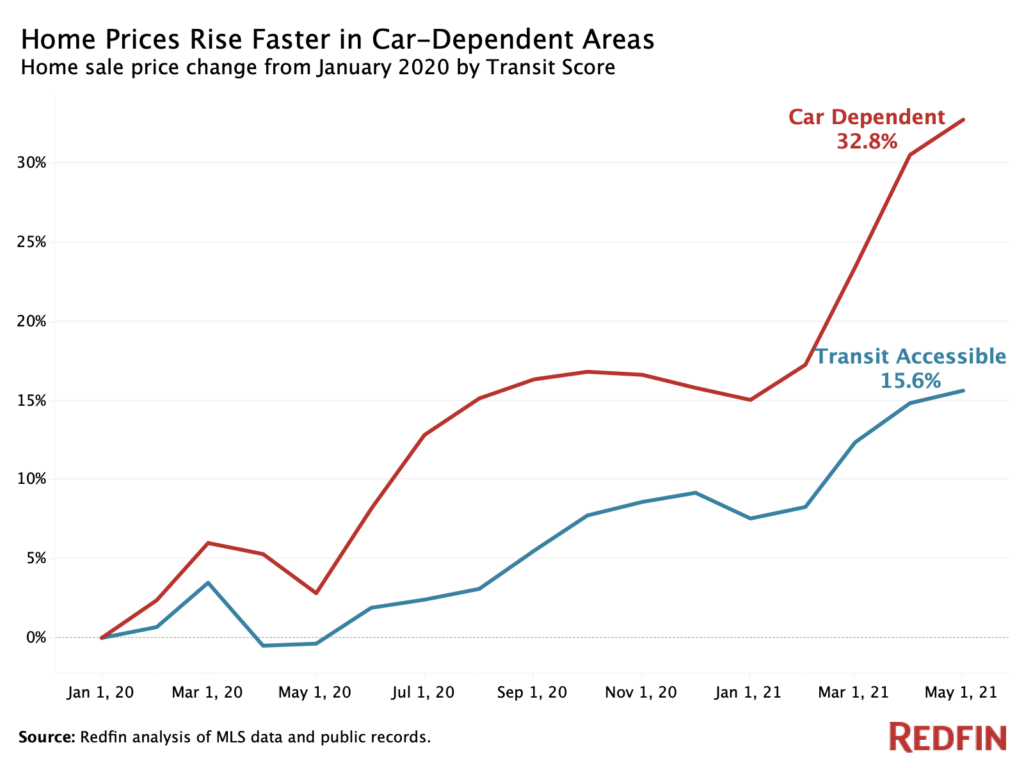Is Proximity to Public Transit Still a Selling Point?
Is Proximity to Public Transit Still a Selling Point?
Since the start of the pandemic, home prices have been rising twice as fast in car-dependent neighborhoods as in transit-accessible areas, according to newly released Redfin research. The trend may be only temporary as social distancing practices that made commuting by train, subway, or bus less practical begin to ease.
The median home sale price in car-dependent areas across the country has risen nearly 33% since January 2020 to a record $418,100, Redfin data shows. In transit-accessible neighborhoods, the median price has risen only by 16% but still reached a record of $540,500.
Fifty-six percent of homes in car-dependent neighborhoods sold for above asking price in May compared to 36% of transit-accessible homes, the Redfin study shows. Homes in car-dependent neighborhoods also tended to sell faster—an average of 19 days versus 38 days for transit-accessible homes.
“Remote work has allowed many home buyers to leave cities for far-flung suburbs,” says Daryl Fairweather, Redfin’s chief economist. “Those suburbs often lack public transit, so new residents drive more often. Hopefully, a less frequent commute will mean fewer hours behind the wheel. But as offices reopen, we may see commuters who used to live in the city and use public transit spending more time driving and emitting more carbon. Governments need to plan for this new reality and start providing more green transit to areas outside of major cities.”
Source:
©National Association of REALTORS®
Reprinted with permission

admin
For all of your Real Estate needs, place yourself in the competent hands of a career Realtor who is a Philadelphia native and Delaware County resident. Skilled, smart and enthusiastic about his work and his life, Anthony DiDonato has the appealing combination of business sense and people skills gives him an edge in an industry that demands both.
Educated at Drexel University with a dual major in accounting and finance and minors in management and psychology Anthony DiDonato offers over 25 years of experience in the real estate industry. He has been a real estate investor since 1985 and a member of H.A.P.C.O. (Landlord Association). He became a licensed Realtor in 1992 and a member of the Local, Pennsylvania and National Associations of Realtors. Anthony DiDonato is also a member of the Computerized Multiple Listings, (MLS) and Internet Marketing Programs. In 1997 Anthony DiDonato became Century 21 All-Elite, Inc. Corporate Secretary.
Anthony DiDonato believes in taking his profession to the highest level of quality service. He is known for finding that “perfect” property in Philadelphia, Delaware County, Chester County, Montgomery County and surrounding areas in Pennsylvania for his buyers and helping his sellers prepare their properties so they sell quickly and efficiently.
When it comes time to negotiate the terms of a contract, Anthony DiDonato has the knowledge, experience, and professionalism applied to meeting – or exceeding – his clients’ expectations. His service to his clients is second to none. His honesty and integrity have been his claim to fame.
For Superior Real Estate Representation in the Delaware Valley, Philadelphia, Delaware County, Chester County, Montgomery County and surrounding areas in Pennsylvania… call Anthony DiDonato.



